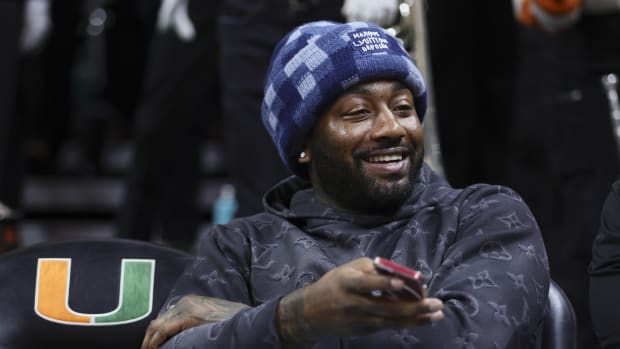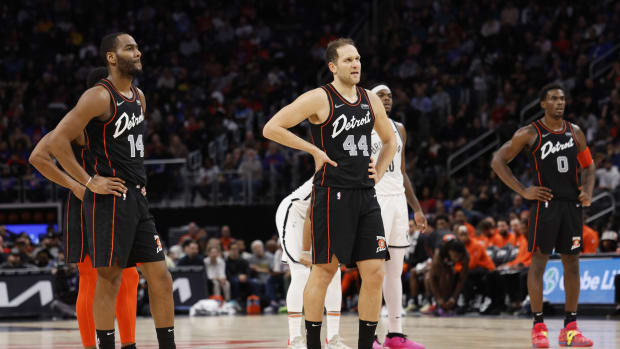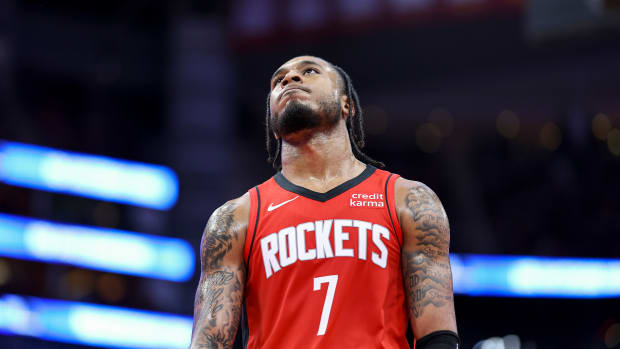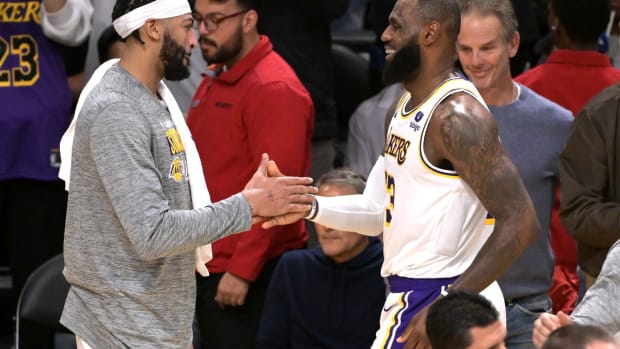High School Standout Jalen Lecque Isn’t Ready for the NBA, But It Might Be Ready For Him
BROOKLYN — This season annual prep-to-pro spotlight has fallen on Jalen Lecque, and his case will be a long game. The Bronx native, a wildly athletic guard with long-term eyes on the NBA and a short-term focus on graduating high school, signed his letter of intent with NC State in November. He has been unable to totally dispel the noise. NBA teams are well aware that Lecque, who turns 19 in June, is expected to be ruled eligible for the 2019 draft based on his age and academic situation. And so many of them sent scouts to the Barclays Center for Sunday night’s Battle in the Apple event, knowing that every glimpse is significant.
Lecque (pronounced Le-Cue) joined New Hampshire prep powerhouse Brewster Academy, which has produced numerous NBA players over the years, for his senior year of high school after spending last season playing in North Carolina. He scored 11 points Sunday in Brewster’s win over St. Thomas More, a game that was a New York homecoming but doubled as a magnified stage for him to showcase his progress. He is more or less playing his cards correctly and keeping his plans close to the vest.
“I’m not worried about that,” Lecque said when asked about the possibility of the draft after Monday’s game, explaining that his focus remains on Brewster’s season. At least publicly, the possibility of the draft versus attending college is a long-term decision. “I talk about it with my family sometimes, but we don’t really get into it, it’s not what we’re focused on right now.”
From a pure basketball standpoint, the prevailing opinion around the league is that Lecque is nowhere close to ready to help an NBA team—after all, he’s a 18-year-old high school player. But, as always, the proposition of drafting a teenage prep prospect is about projection and not preparation, and whether a player is draftable tends to boil down to what caliber of physical tools he possesses. Over the course of the year it takes to finish high school, play a season of college and declare for the draft, a prospect’s athletic toolbox is more often than not a constant. And based on what Lecque can already offer as a development project, the odds are NBA teams will be willing to take the dive.
Listed at 6’4”, Lecque is a gifted run-jump athlete, able to cover ground quickly in transition and elevate for powerful slams. The defensive component of his game is relatively sound at this stage, and he can continue to become a factor on that end with his size and ability to shuffle laterally. There’s a wow factor that accompanies his highlights, and his build more or less passes the eye test. At a glance, Lecque comes with enough long-term upside to warrant immediate draft attention from NBA teams ever-willing to roll the dice.
The catch is that his game is still a work in progress on the offensive end, where his off-the-dribble game has plenty of room for improvement. Lecque’s effectiveness is predicated on creating a step to explode downhill, but he doesn’t yet have the consistent pull-up game to keep better defenders honest, and his jumper is visibly a work in progress. He has worked on transitioning to point guard, the position where his long-term upside lies if he can put things together, but must continue to become a better decision-maker and playmaker. He says he patterns his game after Russell Westbrook, who was also a late-bloomer at the point.
MAHONEY: First-Quarter NBA Awards
Evaluating Lecque was made slightly trickier by the fact he features more off the ball for a Brewster team that features at least five other high-major recruits. He did well to not force shots on Sunday, but wasn’t quite a dominant offensive force either. “I’ve always had to work on my jump shot, my mechanics. I believe I’m getting there, getting more confident with shooting the ball,” Lecque said. “Just passing the ball, not worrying too much about scoring. We have so many talented guys on our team that I don’t have to score every point.”
If recent history is any indicator, this will end up being a business decision for Lecque and his family. He should be ready to help NC State immediately, and could certainly benefit from another year to work on his game, showcase his growth, and potentially turn a corner with his play on the ball. It could a prudent move to bet on his own development and try to solidify himself as a first-round pick in 2020. But should Lecque choose to enter the draft this spring (a combine invite is certainly in the realm of possibility) there should be some degree of financial security available to him.
To use the 2018 class as an analog, consider Anfernee Simons, who made the same jump directly to the NBA after taking a prep year at IMG Academy, and was drafted 24th overall by Portland. It’s important to note that Simons was a more naturally gifted shot creator than Lecque and arguably a more intriguing prospect at the same stage, but it’s feasible to think Lecque could sell a team (perhaps one with multiple draft picks) on his value somewhere in the 20s, and spend time in the G League taking his lumps. According to his draft slot, Simons’ contract pays him just under $4 million over his first two guaranteed seasons and includes two team option years before he hits restricted free agency.
Also recall the case of Hamidou Diallo, who could have entered the 2017 draft after enrolling early at Kentucky during the 2016-17 season, but chose to stay and play out his freshman year. He was not a guaranteed first-rounder in the 2018 draft, but left anyway, and was selected 45th overall by Oklahoma City. Diallo received a three-year, $4 million deal from the Thunder, which reportedly included a portion of their midlevel exception. The third season is a team option, and the deal positions him to hit restricted free agency in 2021. Although it’s not as lucrative as a first-round slot, so long as he performs, Diallo can theoretically get to his second contract faster and leverage a bigger deal earlier in his career.
ROLLINS: Stephen Curry and the Warriors Are Back on Track
If Lecque enters the draft, he’s likely walking into one of these two situations, where if he were to fall into the second round, a team with a long view will be willing to commit time and money to him because of his youth and athletic upside. If a team has the time and wherewithal to develop him, the potential gains can be viewed as more substantial than drafting a college guard who’s two or three years further into his skill development. It’s a highly speculative investment, but can be made on the cheap with relatively low risk at a certain point. You can easily argue that right now, he’s not good enough. It takes just one of 30 NBA teams to decide he’s worth finding out for sure.
All the questionmarks that come with evaluating Lecque and the numerous unknowns in his situation point to the sort of problems NBA evaluators will encounter whenever the league decides to remove the age limit. Imagine having to evaluate and parse the individual merits of not one, but say, two dozen high school prospects (at minimum) each year who have the baseline athletic ability and talent to immediately warrant a financial commitment, but come without a significant college statistical sample. No matter what Lecque deems the right move, whether he’s drafted in 2019 or 2020, case studies like his seem to be where the draft is headed long-term. It’s an uncertain future.



































